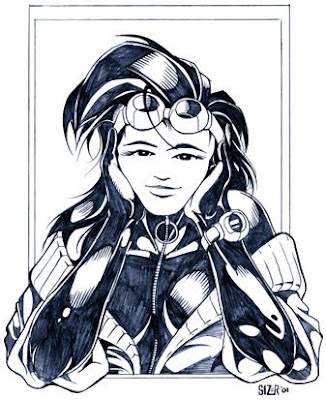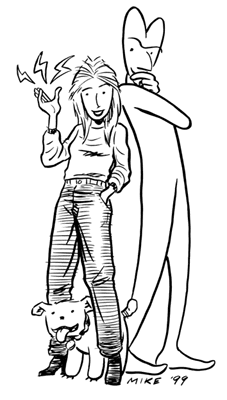Little White Mouse Omnibus Edition (Cafe Digital, 2006)
Story: Paul Sizer
Art: Paul Sizer, with pin-ups and shorts (dream sequences and flashbacks) by various others
Rating: Eight of Ten Stars
It's a commentary on the sad state of the comic book market that an excellent series like "Little White Mouse" went through two publishers, neither of which completed projected plans, and that the creator self-published the collected edition of the series in the end. It's a sad commentary that most of you reading these words, even those among you who are regular comic book and graphic novel readers, haven't heard of "Little White Mouse", one of the finest sci-fi comic books series to be published in the past couple of decades.
"Little White Mouse" is, on the surface, the story of sixteen year-old Loo, a girl who is stranded on a remote mining satellite that is running on automatic after the crew all died in a mysterious accident. As you read the stories of her struggles to survive and eventually get rescued, the scope expands to examine the impact Loo's presumed death is having on her family and friends, and it continues to widen until we start seeing glimpses of the politics and cut-throat inter-stellar business environment of the far future in which the story takes place. There even ends up being a little time travel aspect introduced (and, as I've said in other reviews, I love time-travel stories!) and ends up supplying one of the most interesting and poignient plot-twists in the book. But, ultimately, the main thrust of the story is about love, family, and how it keeps us together and helps us survive.

Sizer has a real talent for creating likable, believable, and distinctive characters. Like all good comics writers, you can tell his characters apart because their dialogue sounds different--and in some cases, he makes a character so distinct that one can almost hear their voices while reading... Loo, Pasqual (a mysterious "ghost" who is marooned on the satellite with her) and "Filthy Jake" Armani (Loo's friend and protector, whose rough exterior hides a loyal soul and generous heart) are particuarly well-written.
On the art-front, Sizer's style is distinctive, but a little rough around the edges and a bit inconsistent quality-wise. As with most young artists, you can see his style evolve and change as the series progresses, and by the second half of the book, the quality of the art stabilizes and remains fairly high. (The first five pages of the book, a "prologue" thatI think was drawn just for the omnibus edition, are of even higher quality that the end of Loo's adventure, so Sizer is clearly still growing and developing as an artist. And I think he's a talent to watch for as the years unfold.)
There are very few comics where I buy every edition. With "Little White Mouse", I purchased the individual issues (some of them from Sizer directly when I met him at a convention, somewhere... Chicago, I think. I did too many shows that summer to know for sure) as they came out from Caliber and Blue Line Pro; I purchased the collected editions that came out from Blue Line Pro; I tried (and failed) to get my hands on the "Retro-Mix Special"--my comic shop guy told me it didn't exist, yet it's in the omnibus, so he was wrong; and I ordered the "Little White Mouse Omnibus" as soon as I heard it was available. Once I got it, I read the story of Loo all over again, for the third time for parts of it.
And it's as good as the first time I read the early issues in that hotel room in Chicago (or Milwaukee or Salt Lake City... where ever I was).
If you like comic books, or if you just like a well-done sci-fi story, I cannot recommend "Little White Mouse" highly enough. The same goes if you know a girl who likes "manga." Give her something good to read.
I also encourage you to visit Paul Sizer's website by
clicking here. It's got a great gallery section devoted to "Little White Mouse," as well as all sorts of information on Sizer's more recent, critically acclaimed projects.

















.jpg)






.jpg)
